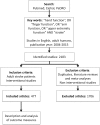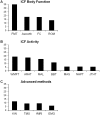Upper Limb Outcome Measures Used in Stroke Rehabilitation Studies: A Systematic Literature Review
- PMID: 27152853
- PMCID: PMC4859525
- DOI: 10.1371/journal.pone.0154792
Upper Limb Outcome Measures Used in Stroke Rehabilitation Studies: A Systematic Literature Review
Abstract
Background: Establishing which upper limb outcome measures are most commonly used in stroke studies may help in improving consensus among scientists and clinicians.
Objective: In this study we aimed to identify the most commonly used upper limb outcome measures in intervention studies after stroke and to describe domains covered according to ICF, how measures are combined, and how their use varies geographically and over time.
Methods: Pubmed, CinHAL, and PeDRO databases were searched for upper limb intervention studies in stroke according to PRISMA guidelines and477 studies were included.
Results: In studies 48different outcome measures were found. Only 15 of these outcome measures were used in more than 5% of the studies. The Fugl-Meyer Test (FMT)was the most commonly used measure (in 36% of studies). Commonly used measures covered ICF domains of body function and activity to varying extents. Most studies (72%) combined multiple outcome measures: the FMT was often combined with the Motor Activity Log (MAL), the Wolf Motor Function Test and the Action Research Arm Test, but infrequently combined with the Motor Assessment Scale or the Nine Hole Peg Test. Key components of manual dexterity such as selective finger movements were rarely measured. Frequency of use increased over a twelve-year period for the FMT and for assessments of kinematics, whereas other measures, such as the MAL and the Jebsen Taylor Hand Test showed decreased use over time. Use varied largely between countries showing low international consensus.
Conclusions: The results showed a large diversity of outcome measures used across studies. However, a growing number of studies used the FMT, a neurological test with good psychometric properties. For thorough assessment the FMT needs to be combined with functional measures. These findings illustrate the need for strategies to build international consensus on appropriate outcome measures for upper limb function after stroke.
Conflict of interest statement
Figures






References
-
- Jørgensen HS, Nakayama H, Raaschou HO, Olsen TS (1999) Stroke. Neurologic and functional recovery the Copenhagen Stroke Study. Phys Med Rehabil Clin N Am 10: 887–906. - PubMed
-
- Parker VM, Wade DT, Langton Hewer R (1986) Loss of arm function after stroke: measurement, frequency, and recovery. Int Rehabil Med 8: 69–73. - PubMed
-
- Kwakkel G, Kollen BJ, van der Grond J, Prevo AJH (2003) Probability of regaining dexterity in the flaccid upper limb: impact of severity of paresis and time since onset in acute stroke. Stroke 34: 2181–2186. 10.1161/01.STR.0000087172.16305.CD - DOI - PubMed
Publication types
MeSH terms
LinkOut - more resources
Full Text Sources
Other Literature Sources
Medical
Research Materials

